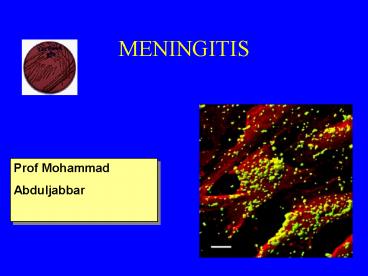MENINGITIS - PowerPoint PPT Presentation
1 / 32
Title: MENINGITIS
1
MENINGITIS
Prof Mohammad Abduljabbar
2
Definition
- Meningitis is defined as an infection of the tow
layers of meninges ( Pia And Arachnoid )
including the fluid in between namely
cerebrospinal fluid (CSF)
3
CAUSES
- 1-Bacterial.
- 2-Viral.
- 3-Fungal.
4
N. meningitides G-ve diplococci
E.Coli G-ve bacilli
Streptococci-GBS Gve cocci
Strep. pneumoniae Gve diplococci
5
Bacterial Meningitis - Organisms
- Birth - 4 wks GBS, E.coli
- 4 - 12 wks GBS, E.coli, Pneumococcus
Salmonella, Listeria, H. Influenza. - 3 months - 3 yrs Pneumococcus, Meningococcus
- H. Influenza.
- 3 yrs adult Pneumococcus, Meningococcus
6
Bacterial Meningitis - Pathogenesis
- Infection of upper respiratory tract
- Invasion of blood stream (bacteraemia)
- Seeding inflammation of meninges
7
Clinical PresentationTriad of Meningitis
- Headache
- Fever
- Neck pain
8
Meningitis Clinical features
- Newborn Infants non-specific symptoms
including - Fever
- Irritability
- Lethargy
- Poor feeding
- High pitched cry, bulging AF
- Convulsions, opisthotonus
9
Meningitis older children
10
Kernigs sign
11
Brudzinskis sign
12
Acute Meningococcaemia
- Neisseria meningitidis serotype Grp B commonest
- Endotoxin causes vascular damage vasodilatation,
third spacing, severe shock - Severe complication
- Waterhouse-Friderichsen syndrome massive
haemorrhage of adrenal glands secondary to
sepsis adrenal crisis-low B.P, shock, DIC,
purpura, adreno-cortical insufficiency
13
Purpura fulminans
14
Clinical features
15
Clinical features
16
Clinical features
17
DIAGNOSIS
- History and physical examination
- Investigations
- CBC
- Renal profile
- CRP
- Coagulation
- Blood gas
- Glucose
- Blood C/S
- Skin scrapings
- PCR
- CXR
- Skin test
18
Diagnosis
LP
19
CSF FINDINGS
Bacterial Viral
TB
Cells 10-100,000
lt2,000 250-500
polys lymph
lymph
Glucose low
normal very low
Protein N or Inc Normal
High
G-Stain
gen ve -ve
ve Zn
20
Bacterial Meningitis Management
- Medical emergency
- Early diagnosis essential
- Immediate optimum treatment
- Intensive supportive therapy
- Rehabilitation
- Prophylaxis to family
- Notification to GP Public Health
21
Bacterial Meningitis/Meningococcaemia Management
- ABC
- ICU admission
- Fluid management aggressive resuscitation
- Dexamethasone only in Pneumococcal and H I
bacteria, given before antibiotics - Inotropes to maintain good blood pressure.
22
Antibiotics
- Less than 2 months of age
- Ampicillin Cefotaxime/- Gentamicin
- Treat for 3 weeks (neonate)
- Over 2 months
- Cefotaxime
- Treat for 7-10 days
23
Prophylaxis
- Rifampicin
- Children 5mg/kg bd x 2/7
- Adults 600 mg bd x 2/7
- Pregnant contact
- Cefuroxime IM x 1 dose
- OR
- Just do T/S and await result
24
Meningitis - Complications
- Septic shock - DIC
- Cerebral oedema
- Seizures
- Arteritis/venous thrombosis
- Subdural effusions
- Hydrocephalus . Abscess . Brain damage
- Deafness
25
Meningococcaemia - poor prognosis
- Onset of Petechiae within 12 hrs
- Absence of meningitis signs
- Shock (BP 70 or less)
- Normal or low WBC
- Normal or low ESR
26
Subdural Effusion
- Failure of temperature to show progressive
reduction after 72 hours - Persistent positive spinal cultures after 72
hours - Occurrence of focal/ persistent convulsions
- Persistence/recurrence of vomiting
- Development of focal neurological signs
- Clinical deterioration after 72 hours especially
ICP
27
Partially treated meningitis
- 50 cases prior antibiotic - alters the findings
in bacterial meningitis - - Accurate history is vital
- CSF mainly lymphocytic not usual polys
- Can have normal glucose
- Positive cultures reduced by 30
- Gram stain reduced by 20
28
Viral meningitis
- Most common infection of CNS especially in lt1yr
- Causes enterovirus (commonest, meningitis
occurring in 50 of children lt3mth ) herpes,
influenza, rubella, echo, coxsackie, EBV,
adenovirus - Mononuclear lymphocytes in CSF
- Symptomatic treatment. Complications associated
with encephalitis and ICP
29
TB Meningitis
- Usually insidious difficult to diagnose in early
stages (fever 30, URTI 20) - Rare in children in developed countries
- If untreated is usually fatal
- Meningitis usually occurs 3-6mths after primary
infection - 1 stage-lasts 1-2wk, fever malaise, headache
- 2 stage-/- suddenly, meningeal signs
- 3 stage-worsening neurological condition, death
30
Mortality/Morbidity
- Bacterial meningitis Overall mortality 5-10
- Neonatal meningitis 15-20
- Older children 3-10
- Strep. pneumonia 26-30
- H. influenza type B 7-10
- N. meningitidis 3.5-10
- 30 neurological complications
- 4 Profound bilateral hearing loss (sensory
neural) in all bacterial meningitis
31
Mortality/Morbidity
- Viral meningoencephalitis Enteroviral fewer
complications - Tuberculous meningitis related to stage of
disease - Stage I-30 morbidity
- Stage II- 56
- Stage III-94
32
THANK YOU































